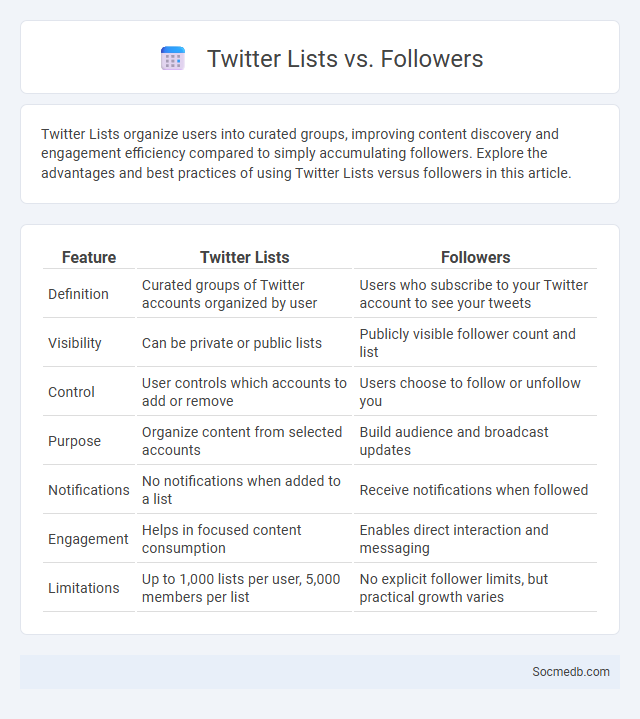
Photo illustration: Twitter List vs Followers
Twitter Lists organize users into curated groups, improving content discovery and engagement efficiency compared to simply accumulating followers. Explore the advantages and best practices of using Twitter Lists versus followers in this article.
Table of Comparison
| Feature | Twitter Lists | Followers |
|---|---|---|
| Definition | Curated groups of Twitter accounts organized by user | Users who subscribe to your Twitter account to see your tweets |
| Visibility | Can be private or public lists | Publicly visible follower count and list |
| Control | User controls which accounts to add or remove | Users choose to follow or unfollow you |
| Purpose | Organize content from selected accounts | Build audience and broadcast updates |
| Notifications | No notifications when added to a list | Receive notifications when followed |
| Engagement | Helps in focused content consumption | Enables direct interaction and messaging |
| Limitations | Up to 1,000 lists per user, 5,000 members per list | No explicit follower limits, but practical growth varies |
Introduction to Twitter Lists and Followers
Twitter Lists enable you to organize accounts into curated groups, making it easier to monitor specific topics or people without cluttering your main feed. Followers represent the users who subscribe to your tweets, directly impacting your reach and engagement rates. Optimizing your use of Twitter Lists can enhance your social media strategy by targeting content more effectively to your audience.
What Are Twitter Lists?
Twitter Lists are curated groups of Twitter accounts organized around specific topics, interests, or industries, allowing users to streamline content consumption and monitor conversations effectively. They enable users to categorize accounts into public or private lists, enhancing content discovery and management by filtering tweets from selected groups without needing to follow every individual account. By leveraging Twitter Lists, users can optimize their social media strategy, boost engagement, and stay updated on niche subjects or key influencers in real time.
Understanding Twitter Followers
Twitter followers represent an engaged audience that reflects your brand's reach and influence on the platform. Analyzing follower demographics, interests, and engagement patterns provides insights into content effectiveness and community growth potential. Leveraging these metrics helps optimize communication strategies and foster stronger connections with target users.
Key Differences: Lists vs Followers
Lists on social media serve as curated groups of users or content, allowing targeted organization and management of specific interests or communities. Followers represent individuals who subscribe to receive updates from a particular account, reflecting the account's influence and reach. Lists offer enhanced content filtering and personalization, while follower counts primarily indicate popularity and audience size.
Benefits of Using Twitter Lists
Twitter Lists enhance user experience by organizing content into targeted groups, improving information filtering and streamlining feed management. They enable monitoring specific topics, industries, or influencers, fostering efficient networking and timely engagement. This feature supports strategic content consumption, boosting productivity and social media effectiveness.
How Followers Impact Your Twitter Presence
Followers directly influence your Twitter presence by expanding your content's reach and increasing engagement through retweets, likes, and comments. A large, active follower base signals credibility and authority, attracting collaborations and opportunities from brands and influencers. Consistent interaction with followers boosts algorithmic visibility, enhancing overall profile growth and influence on the platform.
Privacy and Control: Lists Compared to Followers
Lists on social media provide enhanced privacy and control by allowing you to categorize followers and tailor content visibility, unlike generic follower lists that expose your posts to everyone who follows you. By using custom lists, you can selectively share updates with specific groups, ensuring your personal information and posts remain accessible only to intended audiences. This targeted approach helps you manage your online presence more securely and efficiently, protecting your privacy while maintaining meaningful connections.
Use Cases: When to Use Lists or Rely on Followers
Lists on social media help you organize and prioritize content from specific groups, making it easier to monitor industry trends, competitors, or close connections. Relying on your followers allows for broader audience engagement, essential for building brand awareness and encouraging interaction with your posts. Choose lists for targeted information management and followers for expanding your social reach effectively.
Common Misconceptions About Twitter Lists and Followers
Twitter Lists are often misunderstood as mere followers' collections, but they serve as powerful tools for organizing content and monitoring specific groups or topics efficiently. Many believe follower count directly equates to influence; however, engagement metrics like retweets and replies better reflect Your actual reach and impact. Properly utilized, Twitter Lists can enhance Your social media strategy by filtering relevant conversations without relying solely on your follower base.
Choosing the Best Strategy for Twitter Networking
Maximizing Twitter networking effectiveness requires selecting a strategy centered on targeted engagement with industry influencers and active participation in relevant hashtag conversations. Consistently sharing valuable content, responding promptly to mentions, and utilizing Twitter Analytics to refine outreach efforts significantly enhance connection growth and brand visibility. Leveraging Twitter Lists to organize contacts and monitor competitors also streamlines relationship management and opportunities identification.
 socmedb.com
socmedb.com